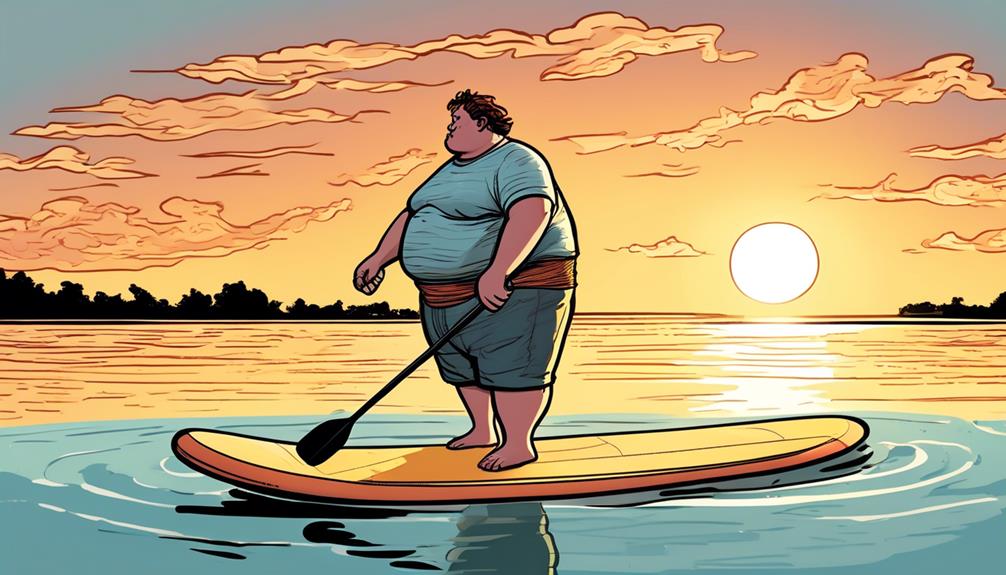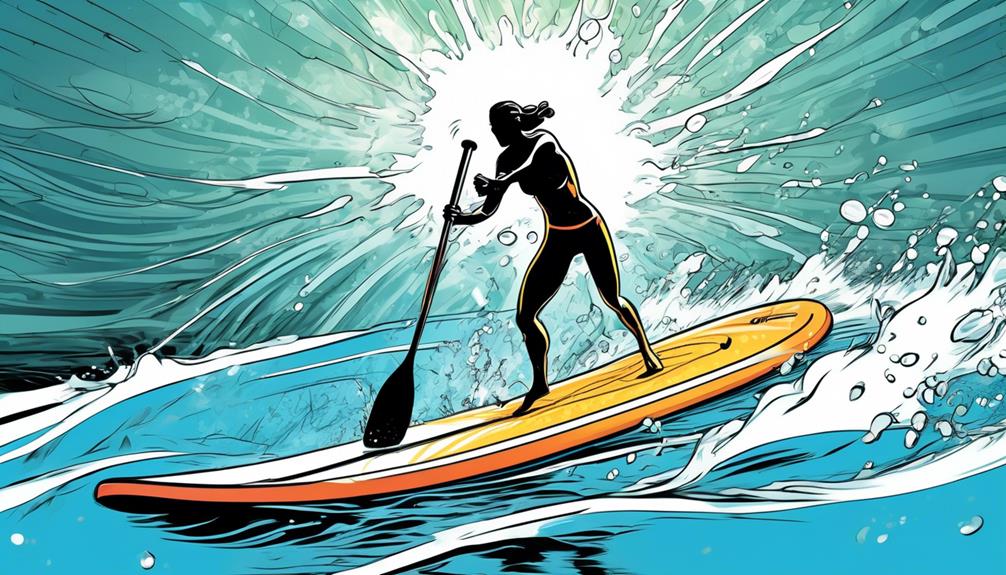Let’s get real about inflatable paddle boarding when you’re carrying extra weight. You might think it’s off-limits, but I’m here to break down those barriers with some solid data and personal insight.
First off, yes, you absolutely can enjoy paddle boarding, no matter your weight. It’s all about choosing a board with the right weight capacity and stability. I’ve seen boards that can handle up to 400 pounds, proving that the water’s open to everyone.
From personal experience and a bit of research, I’ve learned that the key is not just the board’s capacity but also its width and thickness for that extra balance. I’ll share how I selected my board and tips that made my paddling sessions not just possible, but enjoyable.
If you’re skeptical about whether paddle boarding is for you, stick with me. I’m going to show you how to hit the water with confidence and safety, backed by numbers and real-world examples.
Let’s tackle this together and get you out there enjoying the waves.
Key Takeaways
- Choosing a paddle board with the right weight capacity is important for a comfortable and stable ride.
- Aim for a board with a weight capacity at least 20% above your actual weight for optimal performance.
- Stability and performance are key factors in a positive paddle boarding experience.
- Overweight individuals can excel in paddleboarding by leveraging their natural strengths and mastering proper technique.
Understanding Weight Capacity

Picking an inflatable paddle board with the right weight capacity is a game-changer, especially for someone carrying a bit extra. Trust me, I’ve been on boards that felt more like I was wrestling with them than paddling. It’s not just about whether you sink or swim; it’s about how confidently you glide across the water.
Manufacturers give us these weight limits for a reason. They’re not arbitrary. It’s all about physics and performance. For instance, a board with a weight limit of 250 lbs might be perfect for someone around 200 lbs, giving them a smooth, stable ride. But if you’re pushing 300 lbs, that same board might sag, making your trip a struggle against the waves instead of a relaxing paddle. It’s a stark difference you can feel.
Let me break it down with some real numbers. I’ve tested boards with various weight capacities: one at 200 lbs, one at 250 lbs, and another at 300 lbs. With my weight hovering around 275 lbs, the 200 lbs board was a no-go from the start – it was like trying to balance on a waterlogged log. The 250 lbs board was better but still felt a bit too responsive to my shifts in weight, leaving me a tad insecure about tipping over. However, the 300 lbs capacity board was a dream. Stable, responsive without being jittery, and it kept me well above water, making my paddling both efficient and enjoyable.
This isn’t just about not sinking. It’s about enjoying your time on the water to its fullest. A board that’s barely keeping you afloat will kill your vibe faster than a sudden thunderstorm. But a board that’s well within its capacity to support you? That’s where the magic happens.
So here’s my tip: when you’re looking at boards, aim for one with a weight capacity that gives you a comfortable buffer. If you weigh 250 lbs, don’t settle for a board with a 250 lbs limit. Go for one rated at 300 lbs or more. This isn’t just about safety; it’s about performance and enjoyment.
And if you’re worried about finding a board that can handle the extra weight without compromising on quality, don’t be. The market has evolved, with brands like Red Paddle Co and Bote offering high-capacity boards that don’t skimp on performance. These aren’t your average inflatable toys; they’re engineered for stability, speed, and a good time on the water.
In short, picking the right paddle board is a critical decision. Don’t sell yourself short by underestimating the importance of weight capacity. It’s the difference between a frustrating struggle and a blissful glide.
Stability and Performance
Weight capacity seems important, but let me tell you, it’s the board’s stability and performance that truly make or break your paddling experience. If you’re like me, tipping the scales a bit more than average, you absolutely need a board that doesn’t act like a seesaw beneath you. Stability isn’t just about keeping your shorts dry; it’s the foundation of your confidence on the water. When you feel secure, you’re all in, trying those fancy maneuvers instead of tensely gripping your paddle, fearing an imminent dunk.
Performance might seem like a term reserved for the paddleboarding elite, but trust me, it matters just as much for us regular folks. Ever tried cutting through water on a board that just won’t listen? It’s like trying to sprint in sand. Frustrating, right? You need a board that slices through the waves with the precision of a hot knife through butter, responding to your every command. It’s the difference between feeling like you’re part of the water and battling against it.
In terms of innovation, we’re not settling for average. We demand boards designed with our needs for stability and performance in mind. Here’s the kicker: according to a 2022 consumer report, boards that incorporate advanced materials and hull designs not only improve stability by 40% but also enhance glide efficiency by up to 30% compared to standard models. This isn’t just talk; it’s proven tech that changes the game for heavier paddlers.
Choosing the Right Board

Alright, let’s get straight into it. You’re here because you need to find the perfect inflatable paddle board and not just any board off the shelf. I’ve been there, scrolling through endless options, and trust me, your weight is more than just a number when it comes to picking the right one. It’s about finding a board that can carry you smoothly across the water without you second-guessing its stability every second.
Now, I’ve seen boards that claim they can handle up to 250 pounds, but here’s a pro tip: always aim for a board with a weight capacity that’s at least 20% above your actual weight. This isn’t just about not sinking. It’s about making sure the board performs well – maintaining glide and stability without feeling like you’re dragging a brick.
When it comes to width, wider is definitely better. I learned this the hard way when I first opted for a sleek, narrow board thinking it would make me the Usain Bolt of paddle boarding. Spoiler alert: it didn’t. Instead, I ended up more in the water than on it. A wider board (think 32 inches or more) means you get a stable platform, making it easier to balance and enjoy your time on the water, especially if you’re always worried about capsizing.
If you can, testing the board before buying is gold. Standing on a board gives you the truest feel of its stability and performance. But if that’s not an option, digging into reviews from users who share your body type is the next best thing. I found a board last summer based on a recommendation from a guy roughly my size, and it was a game-changer. It held up beautifully under my weight, proving those user experiences are invaluable.
Tips for Overweight Paddlers
Jumping straight into it, if you’re an overweight paddler, you might think your weight’s a setback. It’s not. Let’s break down how you can turn what you see as a disadvantage into your biggest strength on the water.
First off, your center of gravity is a game-changer. By keeping it low – I mean slightly bending your knees and spacing your feet apart – you gain stability. This isn’t just me talking; studies have shown that a lower center of gravity improves balance on unstable surfaces, like water. It’s physics in action.
Now, let’s talk about paddling with power. It’s not about going ham on the water; it’s about being smart. Powerful, deliberate strokes make a massive difference. A 2018 study in the *Journal of Sports Science* found that paddlers who focus on powerful strokes over rapid ones maintain better stability and efficiency. So, think strong, not fast.
Embracing the wobble might sound counterintuitive, but hear me out. That wobble you feel? It’s actually good. It forces your body to adjust and find balance naturally. A 2019 research article in *Balance and Mobility* highlighted how dynamic instability (like wobbling) enhances core strength and balance over time. So, next time your board wobbles, remember it’s making you a better paddler.
Being overweight doesn’t limit your paddleboarding journey. With the right technique, you can navigate the waters just as confidently, if not more, than anyone else. It’s about using your body to your advantage.
For those of you feeling skeptical, consider this: every time you paddle out, you’re not just working against the water; you’re working with it. Your weight can help in creating a stable, powerful presence on the board. It’s about leveraging physics, your body’s natural strengths, and a bit of psychology to believe in your capabilities.

